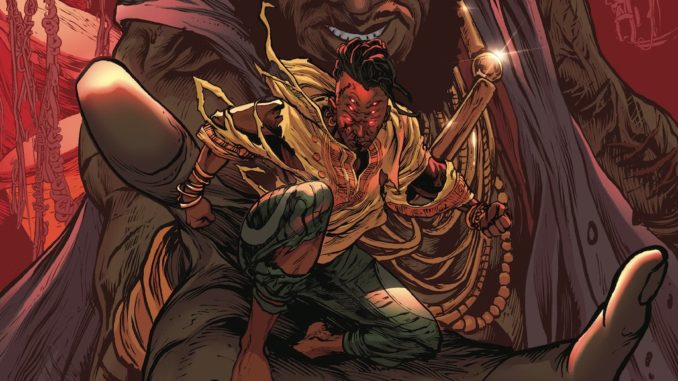
Is’Nana, the son of Anansi the trickster god who appears in African and Caribbean folklore is experiencing a recurring nightmare. Tossing in his web-structure bed, suspended amidst a dark background we see Is’Nana with his multiple eyes and long locs waking and journaling what he can remember. Of course, the reader knows what’s happening but not why. It seems that Ogoun is calling him for a purpose.
Is’Nana has been stuck on the earth plane but has made the best of his situation. He recounts as he writes in his journal the adventures he’s had and that his abilities are able to help people. It is no doubt Is’Nana has developed enemies. While there is joy in his life, there is also the constant battle of protecting humanity. Though it is something Is’Nana chooses, it still weighs heavily on his psyche. In this sense of burnout, he is pulled into Ogoun’s mess. But who is Ogoun and why is he attacking Is’Nana in his dreams? A powerful deity who is known across the African diaspora for his abilities as a warrior and politician, Ogoun’s purpose is not something he is willing to share with his query. Even at the end of the story the purpose for dragging him into an underground fight club scenario is shrouded in mystery. The only thing that we are aware of is that a war is coming, and Ogoun wants Is’Nana on his side. Then the goddess Erzulie in all her voluptuousness visits Is’Nana in the aftermath of his ordeal with her husband Ogoun. Through her Is’Nana begins to heal. In everything he does Is’Nana throws his entire self into, except when it comes to self-love. The artwork in each story follows along with the narrative. In what leads up to the battle arena set up by Ogoun, the panels have strong, clearly defined lines, with a sense of realism. The movement is fluid, like a dance from the drumming to fighting between Is’Nana and his opponents. There’s also a sharp distinction in scale where Ogoun is significantly larger than Is’Nana reflecting their respective god-hoods. In the story where Erzulie visits Is’Nana the colors are bright and welcoming. Throughout the story you feel as if you are enveloped in joyous affection. As Erzulie shows Is’Nana that he must also love himself, he is seen as a small black boy instead of the fierceness of a spider-god. Lines are rounded with an openness as if the darkness has been lifted.
The creator of Is’Nana Greg Anderson Elysee’s latest comic once again interweaves Afrofuturism and folklore. As with Is’Nana and his siblings Afrofuturism works to reflect black life in its fighting spirit, creativity, and joy. But also, in its activism. Is’Nana confronts Ogoun when he is drawn into his realm by insisting his sanity is more important than the iron god’s trifling games. Is’Nana throughout openly talks about his depression and self-doubt. He even momentarily questions who he is. There’s also the ability to understand that there is something missing in his life. The purposeful act of agency can be seen as an aspect of Afrofuturism. And it intermingles well with the predominant Haitian folklore in the deities Ogoun and Erzulie whose function in this comic goes deeper if you know who and what they represent to the cultural heritage of Haiti specifically and to those of African/Caribbean background in general. The layers in what this comic possesses are both entertaining and will have you pursuing knowledge. The essay by Yvonne P. Chireau will whet your appetite to find out more.
Overall, “Is’Nana The Were Spider: Drums of Ogoun” entertains as a now familiar character who’s about to embark on a new adventure with more nefarious threats. A great read awaits you.

Leave a Reply